Brunei has a population of 408,786 people (2014 population census) within an area of 5,765 sq. km and has an average population growth rate of 1.7%. The annual rainfall in the country is 2,500mm along the coast and more than 4,000mm in the hilly interior. It has a tropical climate all year-round with high humidity.
The following is an overview of the IWRM status in Brunei for the key water management issues in Brunei.
- Water Supply Management
Water supply management in Brunei is the responsibility of the Water Services Department/Public Works Department (DWS/PWD) under the Ministry of Development.
Table 1 shows the status of water supply management in Brunei for the year 2010 and 2014 for six key indicators.
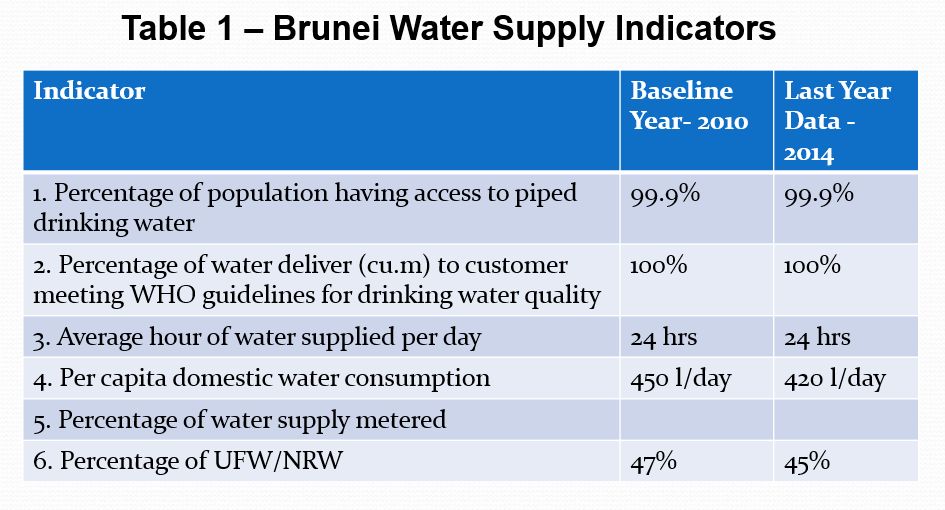
The following is a list of the initiatives carried out by DWS/PWD since the 1970s that has enabled Brunei to achieve the MDG and the WHO standard for water supply services.
- To achieve Millennium Development Goal by 2000.
- To achieve 99% potable piped water to population of the country.
- To attain WHO quality standard on drinking water.
- Adapt to climate change
- Two barrage for main river source constructed to prevent saline intrusion and regulate river flow during long drought.
The following is a list of actions that have been taken by the DWS/PWD to promote IWRM in Brunei.
- Carried out water demand and supplies studies to ensure the timely construction of water supply dams and treatment plants
- Enforcement of Land Act, Town and Country Planning Acts, Water Act, Environment Acts to safeguard the water catchment from pollution
- Carried out Water Resource Studies to identify potential water resources beyond 2035
- Constructed two barrages were in response to the potential impacts of climate change.
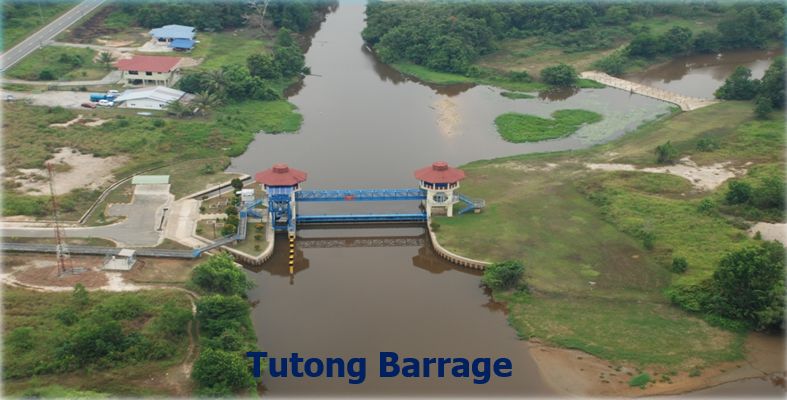
The water supply management challenges faced by the DWS/PWD are the increasing water demand due to (a) Increased in population/social development, (b) Industry development & growth and (c) Economic development & growth. Also, there are excessive water leakage and wastage in the water supply system and high capital consumption with a low water tariff that does not encourage water saving habits.
In order to encourage water conservation with a target to reduce the per capita water consumption from 420 litres/day to 350 litres/day within 3 years a Water Conservation Unit (WCU) has been created in 2012. The following are the list of activities of the WCU:
- Set the KPI on per capita consumption per day. Target NRW reduction by 5% by 2015/2016.
- Promote water savings habits through traditional media, social media, school and private-partnership (MOU).
- Install water-efficient devices & sanitary fittings.
- Promote rain-water harvesting.
- Organize water-conservation event – WWD, REACH.
- Distribution of water conservation kits- thimbles, leaflets.

To support its mission and address the above water supply management challenges the WSD/PWD implements the following Capacity Building and Risk Management/Robustness activities.
- Strengthen Human Resource Development through training programs and seminars.
- Attachment with other International Corporation such as PUB, Singapore and Tokyo Water Institute.
- Good governance, Strategic planning & KPI program.
- Risk management/Robustness
- Auditing Critical Operational Assets for backup systems against major failure such as pumps, power supply and control panels.
- Public Health Assurance: ensured by periodical two hourly testing at water treatment plants and at random by third party (MOH) at consumer points.
- Enhancement of Water Quality Monitoring with new water lab and 11 additional new water quality parameters.
- Dam safety and monitoring system through engagement of International dam safety experts.
The long term development goals of the WSD/PWD are as follows:
- Ensure continuous, safe, reliable, adequate water supply
- Reviewing Legislative Acts & enhance enforcement
- Improve robustness (risk management)
- Promote effective operating environment & capacity building
- Adopt best practices and management tools
- Reduce NRW
- Increase water conservation activities
- Moving towards e-Governance for improvement
- Adopting and innovate the best practice in IWRM
- Water Sanitation Management
Water sanitation management in Brunei is the responsibility of the Department of Drainage and Sewerage/Public Works Department (DDS/PWD) under the Ministry of Development. The following tables show the status of water sanitation management in Brunei for the year 2009 and 2013 for nine key indicators.
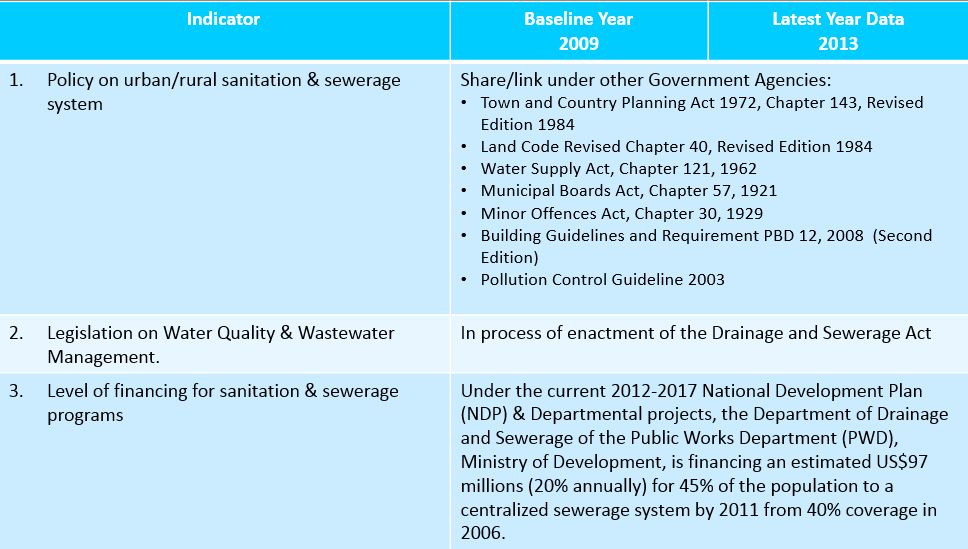


The figure below shows the water sanitation coverage in Brunei. It can be seen that 92% of Brunei’s population are served by the public sewerage system and septic tanks.

The figure below shows the sewerage asset coverage in Brunei whereby the country has been divided into 24 sewerage catchments.
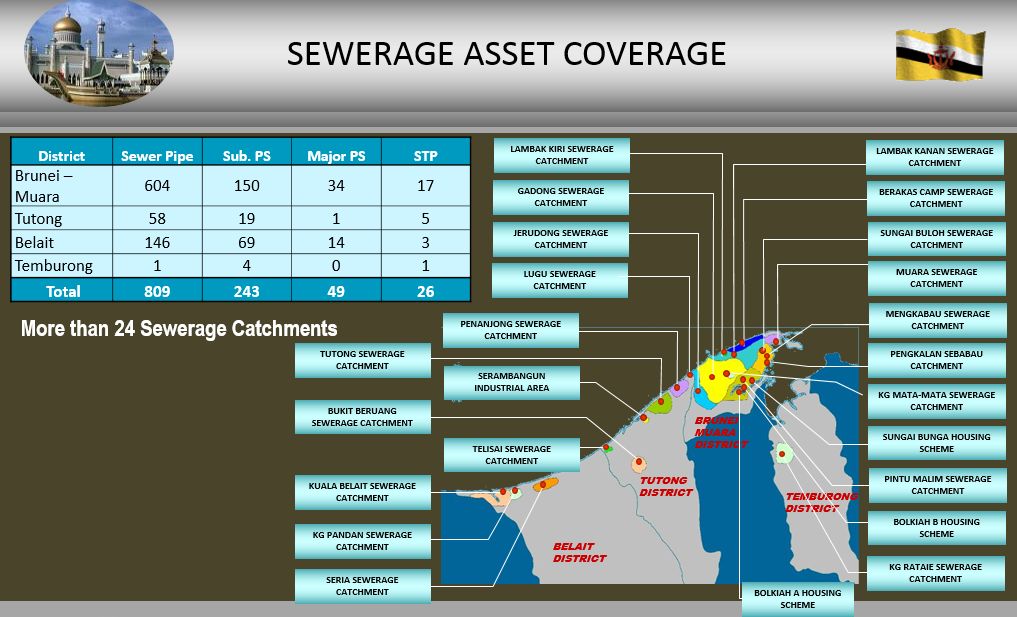
The following are the water sanitation issues in Brunei:
- Jurisdiction Issues – There is a lack of public awareness on the jurisdiction and maintenance responsibility for water sanitation.
- 10% of the population are still without proper basic water sanitation (direct discharge of sewage into the ground or water courses)
- High infiltration of sewage to the ground due to broken or decaying sewerage pipes.
- Construction and maintenance of public sewerage systems e.g. issues of house connection, sewerage systems to be kept in proper order at cost of owners and line of jurisdiction.
- Damage caused to public sewers by the public
- Regulations to protect the public sewers
- Sewer Protection Zone – No person shall carry out any works, either permanent or temporary, within the sewer protection zone without the prior written approval of DDS.
- Sewer Setbacks – No buildings and structures shall be erected over or within the sewer setbacks.
- Discharge of sewage effluent from STP and septic tank.
- Currently the British Royal Commission discharge standard used for STP only.
- No standard discharge for septic tank.
- Max allowable concentrations (Trade Effluent Regulations)
- Grease Trap to be provided at all eating establishment
- Desludging shall be undertaken regularly and all records shall be kept and given copy to DDS.
- Trade effluent from car workshops discharged into public sewerage system or any drain-line
- Prohibition on discharge of dangerous or hazardous substances or trade effluent containing dangerous or hazardous substance.
The following are the policies and legislation on water sanitation in Brunei:
- Drainage and Sewerage Act in process of enactment
- Currently share/link under other Acts i.e. :
- Town and Country Planning Act 1972, Chapter 143, Revised Edition 1984
- Land Code Revised Chapter 40, Revised Edition 1984
- Water Supply Act, Chapter 121, 1962
- Municipal Boards Act, Chapter 57, 1921
- Minor Offences Act, Chapter 30, 1929
- Building Guidelines and Requirement under PBD 12, 2008 (Second Edition)
- Pollution Control Guidelines for Industrial Development – JASTRE/MOD/2002
The figure below shows an example of the water sanitation improvement strategies in Brunei.
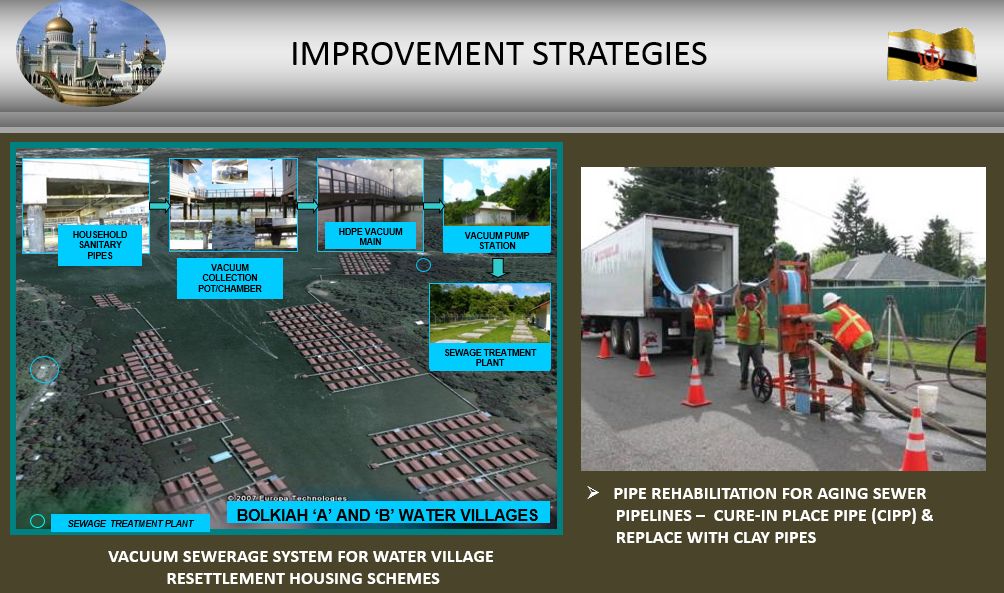
The figure below shows an example of other initiatives to improve the water sanitation system in Brunei.
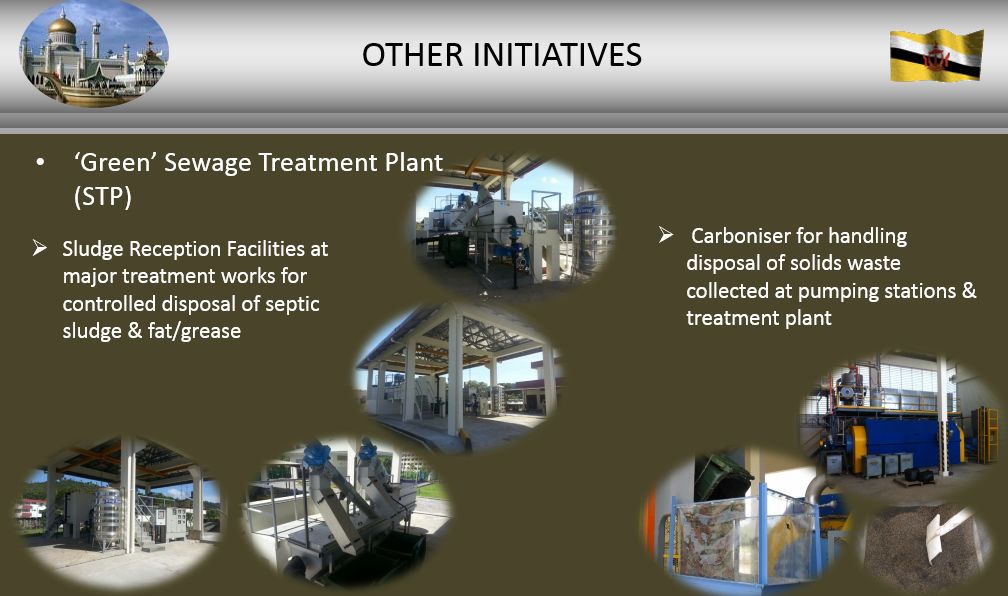
The following are the river water quality monitoring activities carried out in Brunei.
- Increase river water sampling frequency & stations, from current 10 locations along Sungai Brunei twice a month, to include also the drainage/stormwater outfalls at commercial and high density residential areas
- Improvement for sewerage laboratory management and practices; ISO certifications (ISO 17025 and ISO 14002) & increase water quality parameters
The figure below shows the Water Sanitation Action Plans of Brunei.
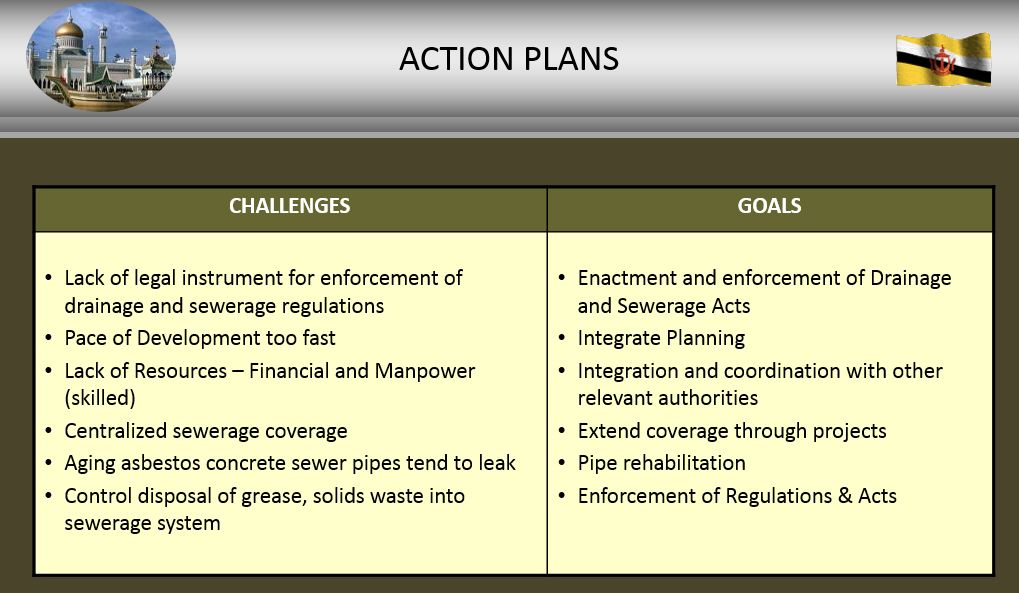
 The following is a list of the initiatives carried out by DWS/PWD since the 1970s that has enabled Brunei to achieve the MDG and the WHO standard for water supply services.
The following is a list of the initiatives carried out by DWS/PWD since the 1970s that has enabled Brunei to achieve the MDG and the WHO standard for water supply services.
 The water supply management challenges faced by the DWS/PWD are the increasing water demand due to (a) Increased in population/social development, (b) Industry development & growth and (c) Economic development & growth. Also, there are excessive water leakage and wastage in the water supply system and high capital consumption with a low water tariff that does not encourage water saving habits.
In order to encourage water conservation with a target to reduce the per capita water consumption from 420 litres/day to 350 litres/day within 3 years a Water Conservation Unit (WCU) has been created in 2012. The following are the list of activities of the WCU:
The water supply management challenges faced by the DWS/PWD are the increasing water demand due to (a) Increased in population/social development, (b) Industry development & growth and (c) Economic development & growth. Also, there are excessive water leakage and wastage in the water supply system and high capital consumption with a low water tariff that does not encourage water saving habits.
In order to encourage water conservation with a target to reduce the per capita water consumption from 420 litres/day to 350 litres/day within 3 years a Water Conservation Unit (WCU) has been created in 2012. The following are the list of activities of the WCU:
 To support its mission and address the above water supply management challenges the WSD/PWD implements the following Capacity Building and Risk Management/Robustness activities.
To support its mission and address the above water supply management challenges the WSD/PWD implements the following Capacity Building and Risk Management/Robustness activities.


 The figure below shows the water sanitation coverage in Brunei. It can be seen that 92% of Brunei’s population are served by the public sewerage system and septic tanks.
The figure below shows the water sanitation coverage in Brunei. It can be seen that 92% of Brunei’s population are served by the public sewerage system and septic tanks.
 The figure below shows the sewerage asset coverage in Brunei whereby the country has been divided into 24 sewerage catchments.
The figure below shows the sewerage asset coverage in Brunei whereby the country has been divided into 24 sewerage catchments.
 The following are the water sanitation issues in Brunei:
The following are the water sanitation issues in Brunei:
 The figure below shows an example of other initiatives to improve the water sanitation system in Brunei.
The figure below shows an example of other initiatives to improve the water sanitation system in Brunei.
 The following are the river water quality monitoring activities carried out in Brunei.
The following are the river water quality monitoring activities carried out in Brunei.

